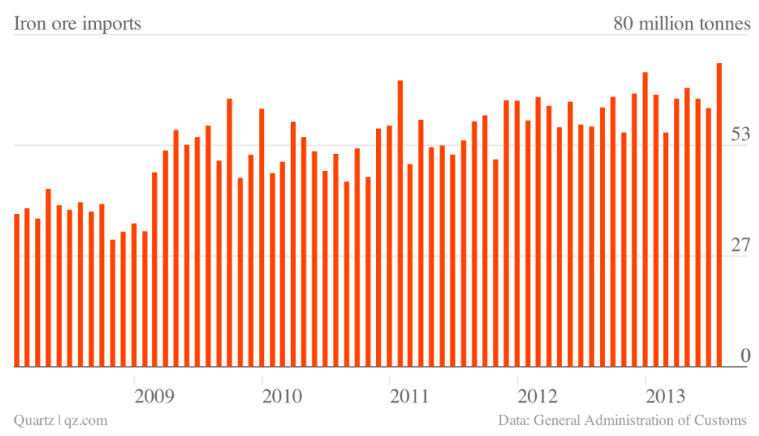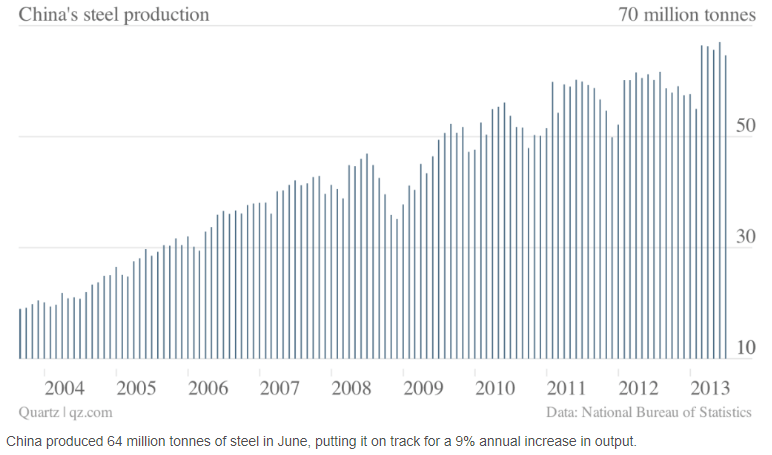
Quartz’s Gwynn Guilford has written an interesting and potentially worrying article examining some alternative theories behind the recent surge in Chinese iron ore demand and steel production.
According to Guilford, Chineses imports of iron ore jumped 26.7% in the year to July 2013, to levels higher than the stimulus-induced infrastructure bonanza between 2009 and 2012, when China’s authorities pumped $11.2 trillion into the economy:

Similarly, Chinese steel production has also lept to record highs:

However, Guilford questions whether the surge in iron ore demand and steel production are sustainable and based upon fundamentals.
In relation to steel, Guilford points to arguments that Chinese steel firms are keeping their furnaces going so that they can keep lines of credit open with banks and avoid defaulting on existing loans:
It’s so hard to find buyers that steel mills are now storing 225,000 tonnes of steel, up 1.8% from last year. By one estimate the industry has a fifth more production capacity than it needs. And of China’s major steel mills, 40 out of 86 operated at a loss in H1 2013.
One answer might be that Chinese steelmakers are keeping their furnaces going not to build more skyscrapers, but quite simply as proof that they’re busy so they can keep lines of credit open with banks, as Reuters reports—probably to avoid defaulting on existing loans.
That story should sound familiar: It’s been happening in other industries all over China. The economy is slowing, crimping cash-flow and leaving companies without funds to cover bad debts taken on during the infrastructure boom.
Similar dynamics could be in play for iron ore, where steel companies are reportedly using iron ore as collateral for loans:
As Société Générale’s Wei Yao noted today, the import boom could signal “reviving [of] commodity financing as a way of coping with domestic liquidity squeezes.” In other words, the cash crunch in May and June meant steel companies started using iron ore as loan collateral…
Why would they do that? Because you can get a lot more credit for a pile of iron ore than the pile is actually worth, and then you can go speculate with that capital on, say, real estate. An article in Time Weekly offers a series of disquieting quotes on how this works from interviews in Shanghai, the hub of iron ore-trading…
“For example, a steel company puts $1 million worth of goods in a warehouse. He then pledges this collateral to a dozen or so banks. Just like that, $1 million in goods becomes $10 million in capital. The risk to banks is obviously really high. When steel prices were up, it was hard to realize what was going on. But when they fell, companies couldn’t repay their loans and their bosses skipped town. The boss doesn’t care about the iron ore any more now that he’s turned $1 million into $10 million. So the loss all falls on the bank.” – A general manager of a steel trading company.
And what the banks think about that:
“The situation is extremely pessimistic, and the risk of not getting our loans back is huge.” – a senior manager at a Jiangsu bank branch. “About 60% of loans to steel companies are non-performing loan. At present, we haven’t received back any of the credit extended to steel companies.” – a Bank of Communications executive.
Whether there is substance to these theories is a moot point. I will point out, however, that Reuters last month published an article citing similar phenomenom for copper:
A crackdown in China aimed at curbing distorted credit growth has triggered growing demand for the use of commodities as collateral to raise cash, causing distortion of another kind in the international trade of copper.
China’s copper imports rose to a nine-month high in June and are likely to stay strong through the third quarter on growing demand for using copper-backed financing as a cheaper and more accessible alternative to bank borrowing.
Financing demand led copper imports into China in June to buck the wider trend of falling shipments in industrial raw materials as economic growth slowed…
For the broader economy, the persistence of China’s ‘cash for copper’ financing scheme underscores the difficulties Beijing face in controlling the grey credit market.

